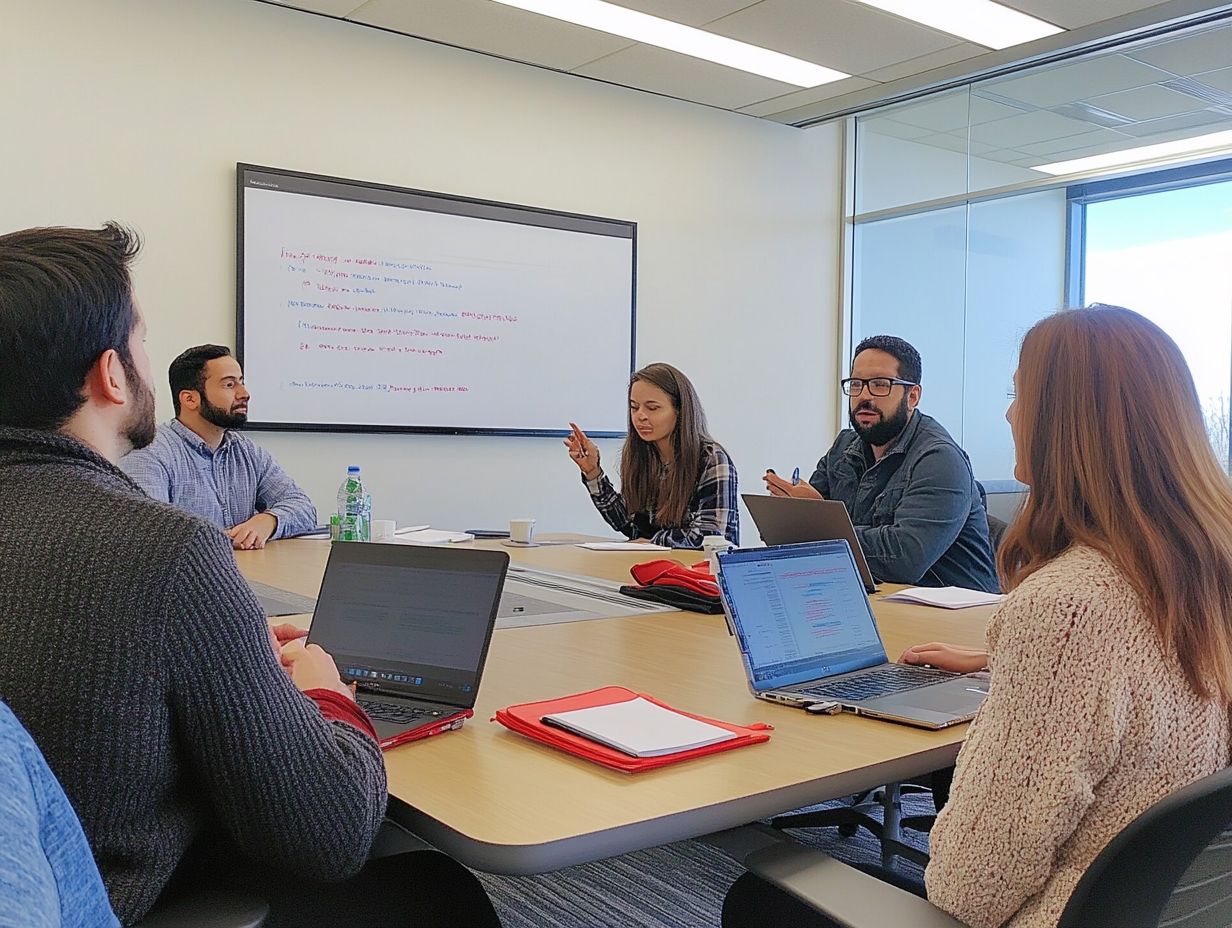How to Approach Coverage Conversations
Navigating coverage conversations can feel daunting, but with the right tools, you can turn them into productive and even exciting opportunities for growth! Whether you re discussing insurance, project management, or any topic that requires clear communication about responsibilities and expectations, this article will guide you through the process.
You ll understand what coverage conversations entail and how to effectively prepare and initiate them. You ll uncover strategies for addressing common concerns, handling objections, and maintaining relationships after your discussions.
Equip yourself with the tools to make these conversations not only more productive but also less stressful. Dive in to enhance your communication skills and ensure clarity in your coverage discussions.
Contents
- Key Takeaways:
- Understanding Coverage Conversations
- Preparing for Coverage Conversations
- Initiating Coverage Conversations
- Addressing Common Concerns and Questions
- Following Up After Coverage Conversations
- Frequently Asked Questions
- What is the best way to start a coverage conversation?
- How can I prepare for a coverage conversation?
- What should I consider when discussing coverage options with an insurance provider?
- What are some important questions to ask during a coverage conversation?
- How can I ensure I am getting the right coverage for my needs?
- What should I do after a coverage conversation?
Key Takeaways:

- Approach coverage conversations with a clear understanding of what they are and the goal of finding the best coverage for your needs.
- Come prepared with all necessary information and be ready to communicate effectively to ensure a successful conversation.
- Address common concerns and objections by providing solutions and following up to maintain positive relationships.
Understanding Coverage Conversations
Understanding coverage conversations is crucial for cultivating a vibrant newsroom culture. Here, corporate women and journalists can engage in challenging discussions, including how to handle coverage disputes, with emotional intelligence.
These dialogues play an important role in shaping discussions around sensitive subjects and fostering authentic communication. Creating a safe space encourages open dialogue, allowing team members to share perspectives and tackle disagreements constructively.
What are Coverage Conversations?
Coverage conversations are nuanced dialogues that delve into sensitive topics. They demand understanding of the emotions at play for everyone involved.
You can encounter these discussions in both personal and professional settings, where misunderstandings may linger. Cultivating an atmosphere of trust and open communication helps you navigate the emotional landscape often underlying conflicts.
Recognizing and validating feelings paves the way for empathetic exchanges. This encourages collaboration in finding solutions, transforming potentially contentious interactions into opportunities for growth and deeper connections.
Refining your skills in emotional awareness and active listening can greatly enhance the effectiveness of your coverage conversations.
Preparing for Coverage Conversations
To prepare for coverage conversations, establish clear intentions and understand the emotional landscape of everyone involved. By learning how to make coverage work for you, you can use effective communication strategies to foster productive outcomes.
Gathering Necessary Information

Gathering essential information before entering a coverage conversation requires engaging in role-playing and scenario work. This allows you to anticipate potential questions and challenges.
These techniques are invaluable as they enable you to step into different perspectives. This broadens your understanding of possible arguments that may arise. By immersing yourself in role-playing, you can practice your responses and refine your communication skills.
It’s crucial to formulate clear and concise questions. This streamlines the conversation and reduces ambiguity. Clarity fosters constructive exchanges, ensuring everyone feels understood and respected, leading to more productive discussions.
Initiating Coverage Conversations
Initiating coverage conversations demands your unwavering commitment to empathetic listening. You must foster an environment where open dialogue and honest feedback can thrive, especially when learning how to navigate the coverage landscape.
Effective Communication Strategies
Effective communication strategies are essential in coverage conversations. They highlight the importance of really paying attention when someone speaks and understanding diverse backgrounds to encourage the sharing of varied perspectives.
These strategies include techniques designed to cultivate a more inclusive and engaging dialogue. For instance, active listening goes beyond hearing words; it involves interpreting the emotions and intentions behind them. This is particularly crucial when discussing sensitive topics.
By recognizing and respecting the unique cultural contexts individuals come from, you can significantly elevate your conversations. A case study in a healthcare setting illustrates this point, showing that medical professionals who embraced these techniques achieved better patient outcomes and increased satisfaction.
Implementing tailored training programs centered on these communication strategies enables organizations to create environments where diverse opinions are genuinely valued and understood.
Addressing Common Concerns and Questions
Addressing common concerns and questions during coverage conversations is crucial for managing expectations and fostering constructive dialogue. This is especially important when navigating objections or delivering negative feedback, as understanding how to use coverage to your advantage can significantly enhance communication.
Proactively engaging with these elements creates a more transparent and effective communication environment.
Handling Objections and Providing Solutions

Handling objections during coverage conversations focuses on building trust and employing effective conflict management techniques to offer viable solutions.
Mastering these skills is essential for maintaining productive dialogue, especially when you encounter resistance. By understanding your client or colleague’s perspective, you can foster empathy and tailor your response to their concerns.
Really paying attention when someone speaks is crucial. When you acknowledge objections and respond thoughtfully, you show that their opinions matter. Employing conflict management strategies, such as finding common ground or reframing the conversation, can help ease any tension.
By developing these techniques, you equip yourself with the tools to navigate challenging discussions, paving the way for more effective collaboration and stronger professional relationships.
Following Up After Coverage Conversations
Don’t underestimate the power of following up after your conversations! It’s a game-changer for building trust and ensuring that every action item is addressed in future discussions. This practice demonstrates your commitment and reinforces accountability, paving the way for more productive interactions ahead.
Next Steps and Maintaining Relationships
The next steps after your coverage conversation revolve around taking deep breaths, maintaining your composure, and focusing on nurturing relationships while implementing the agreed-upon action items.
This approach is crucial for creating a constructive environment where everyone feels valued and heard. It s helpful to jot down the specific commitments made during the discussion and establish a timeline for follow-up.
Regular check-ins can serve as gentle reminders of these commitments, reinforcing accountability without adding unnecessary stress. Nurturing relationships requires active listening and empathy; engaging in mindful communication helps you express any concerns that may arise later.
By prioritizing emotional regulation and maintaining respectful dialogue, you can cultivate trust within the team, paving the way for smoother collaborations in the future.
Frequently Asked Questions
What is the best way to start a coverage conversation?

The best way to start a coverage conversation is by doing some research beforehand. Look into the coverage options available and have a general understanding of how to foster open discussions about coverage. This will help guide the conversation and ensure you ask the right questions.
How can I prepare for a coverage conversation?
To prepare for a coverage conversation, gather details about your current coverage. It’s also helpful to learn how to discuss coverage needs with family, understand your needs and budget, and explore different options.
What should I consider when discussing coverage options with an insurance provider?
Consider your needs, maximum amount covered, deductibles, and any limits. Don’t forget to ask how the coverage safeguards you in emergencies.
What are some important questions to ask during a coverage conversation?
Ask these questions during your conversation:
- What s included in the coverage?
- What are the deductibles?
- What s the total cost?
- Are discounts available?
How can I ensure I am getting the right coverage for my needs?
To get the right coverage, clearly define your needs and budget. Compare quotes from multiple providers to find the best match.
What should I do after a coverage conversation?
After your conversation, review all the information shared. Take your time to weigh your options and don t hesitate to follow up with any questions.
Ready to explore your coverage options? Start comparing quotes today!






